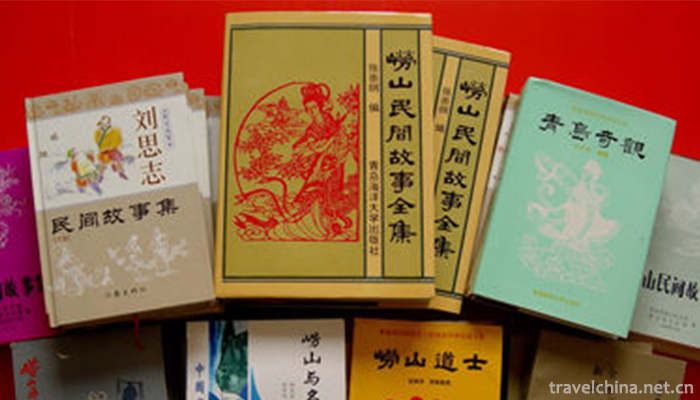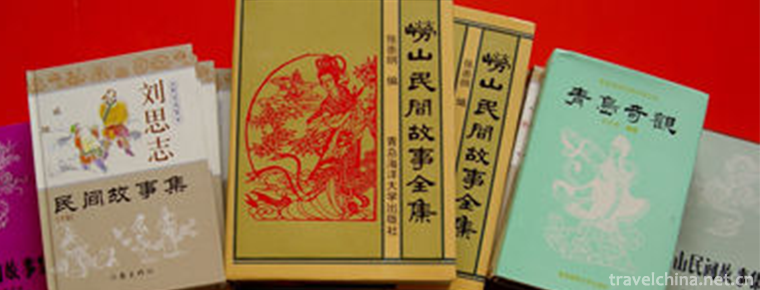Laoshan Folk Stories
Laoshan Folk Stories
Laoshan folk tales, commonly known as Lagua, are oral literature created by the local people of Laoshan Mountain in Shandong Province for thousands of years. There were few written records before liberation.
On June 7, 2008, Laoshan folk tales were listed in the second batch of national intangible cultural heritage list with the approval of the State Council.
Historical origin
Laoshan folktales have a wide range of categories, a large number and rich content. From the collected content of Laoshan folktales, it can be inferred that Laoshan folktales first occurred in ancient times. According to the biography of Pu Songling in Shandong Province, in April of the eleventh year of Kangxi (1672), Pu Songling, 32, traveled to Laoshan with the local gentry Gao Hu and Tang Menglai. Inspired by the folklore stories of Laoshan at that time, he wrote short stories Xiangyu and Laoshan Taoists on the theme of enduring winter, peony and Laoshan Taoists, which were also the earliest writings of Laoshan folk stories.
primary coverage
The contents of Laoshan folktales include "myths", "legends", "stories" and so on, covering more than 5600 natural change myths, heroic myths, historical legends, religious legends, fairy tales, mountain and river legends, specialty legends, ghost and fox ghost stories, animal stories, life stories, wit character stories, etc. Influenced by nature, geographical environment and Taoist culture, among the local folktales in Laoshan, the most numerous and distinctive ones are the legends of local customs, religious figures, ghosts and foxes, ghosts and ghosts, and sea stories.
Inheritance significance
Laoshan folk tales are characterized by the convergence of local popular culture and mountain and sea culture, and evolve in the mutual penetration of secular culture and religious culture, with distinct regional characteristics. It has high historical and literary value.


-
1.Detian waterfall
Detian Waterfall is located in Detian Village, Shuolong Town, Daxin County, Chongzuo City, Guangxi Zhuang Autonomous Region. It is located in the upper reaches of Guichun River on the border between C
Time 2018-12-12 -
2.Tengchong Volcanic Hot Sea Tourist Area
The volcanic hot sea is located 20 kilometers southwest of Tengchong County. It covers an area of 9 square kilometers. There are more than 80 large gas springs and hot springs. Among them
Time 2018-12-12 -
3.Beijing Planning Exhibition Hall
Beijing Planning Exhibition Hall, located in Qianmen East Street (east side of old Beijing Railway Station) of Dongcheng District of Beijing, is renovated on the basis of the original building.
Time 2018-12-26 -
4.Niulang and Zhinu Scenic Spot
Niulang Zhinu Scenic Area is located in Yanya Town, southeast of Yiyuan County, Shandong Province, 15 kilometers away from the county town. The scenic area is mainly composed of Daxianshan Mountain
Time 2019-02-07 -
5.Story telling in Beijing dialect with drum accompaniment
Jingyun Dagu is one of the Chinese folk songs. Developed from the popular wooden drum in Cangzhou and Hejian of Hebei Province, it was formed in Beijing and Tianjin. After the introduction of Hebei wo
Time 2019-05-07 -
6.Brow tune
Meihu Opera is a local traditional drama in Shaanxi Province. From the development of the floor stall rap and social fire, the floor stall and social fire performances always focus on singing. Its act
Time 2019-06-01 -
7.Cooking Techniques of Beef and Mutton
Strict raw materials for roasting whole sheep should be two-year-old lambs. Paste made of egg yolk, salt, cumin, pepper, flour, etc. will be applied to the whole sheep after treatment, and the head of
Time 2019-06-08 -
8.conjuring tricks
Conjuring tricks is one of the traditional Chinese acrobatics. Performers use agile methods to create audiovisual illusions, performing various objects, animals or water and fire and other rapid incre
Time 2019-07-01 -
9.Southwest University of Science and Technology
Southwest University of Science and Technology is located in Mianyang City, Sichuan Province. The school is a university built jointly by the Sichuan Provincial People's Government and the Ministry of
Time 2019-08-31 -
10.Civil Aviation Flight University Of China
The school is directly under the Civil Aviation Administration of China. Its predecessor was established in May 1956 with the approval of Premier Zhou Enlai. Chairman Mao Zedong appointed the aviation
Time 2019-08-31 -
11.Cross stitch of Chinese embroidery
The earliest cross stitch was embroidery on animal fur fabrics with silk extracted from silkworm cocoons. Later, it was used to decorate clothes and furniture. Cross stitch, with its simple embroidery method, noble and gorgeous appearance, exquisite
Time 2020-12-12 -
12.Yibin science and technology
In 2019, there are 34 new high-tech enterprises, 13 provincial science and technology achievements transfer and transformation demonstration enterprises, 2 provincial science popularization bases and 6 Municipal Science Popularization base
Time 2020-12-18